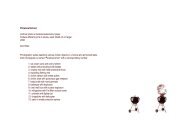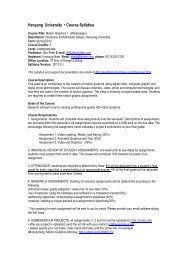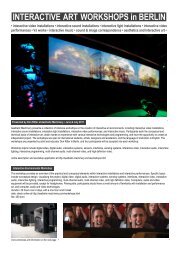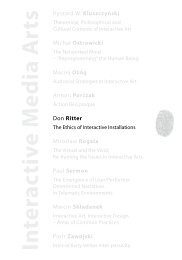Works by Don Ritter compilation - Aesthetic Machinery by Don Ritter
Works by Don Ritter compilation - Aesthetic Machinery by Don Ritter
Works by Don Ritter compilation - Aesthetic Machinery by Don Ritter
Create successful ePaper yourself
Turn your PDF publications into a flip-book with our unique Google optimized e-Paper software.
1<br />
Selected <strong>Works</strong> <strong>by</strong> <strong>Don</strong> <strong>Ritter</strong>
Selected <strong>Works</strong> <strong>by</strong> <strong>Don</strong> <strong>Ritter</strong><br />
installations<br />
Vested 3<br />
Vox Populi 6<br />
Intersection 9<br />
O telephone 12<br />
Skies 15<br />
TV Guides 17<br />
Fit 18<br />
performances<br />
Orpheus 19<br />
Badlands 20<br />
Digestion 22<br />
Elephant Keyboard 24<br />
image works<br />
The Collector Series 25<br />
Personal Armor 29<br />
early works 30<br />
online documentation<br />
links to online videos provided in this document<br />
documentary website at http://aesthetic-machinery.com<br />
detailed work documents for exhibitors at http://aesthetic-machinery.com/documents.html<br />
2013.5.8<br />
biography<br />
<strong>Don</strong> <strong>Ritter</strong> (b. 1959) is a Canadian artist, designer, and writer who has been active<br />
internationally in the field of digital media art since 1986. His large, interactive<br />
installations enable audiences to control their experiences through body motion,<br />
position, or voice. During his interactive performances, video projections are intricately<br />
controlled <strong>by</strong> live music. <strong>Ritter</strong>’s work has been presented at festivals, museums, and<br />
galleries throughout North America, Europe, and Asia. His recent writings examine the<br />
relationships between aesthetics, ethics, and digital media.<br />
<strong>Ritter</strong>’s interactive video-sound installations and performances have been presented<br />
at SITE Santa Fe (USA), Winter Olympics 2010 Cultural Olympiad (Vancouver),<br />
Metrònom (Barcelona), Sonambiente Sound Festival (Berlin), Exit Festival (Paris), Ars<br />
Electronica (Linz), and New Music America (New York City). His most widely exhibited<br />
work is Intersection, an interactive sound installation that has been presented in nine<br />
countries since 1993. <strong>Ritter</strong>’s work between 1988 and 1993 focused on performances<br />
of interactive video controlled <strong>by</strong> live, improvised music using his Orpheus software. He<br />
has collaborated primarily with musician George Lewis and also worked with musicians<br />
Nick Didkovsky, Amy Denio, Thomas Dimuzio, Ikue Mori, Geneviève Letarte, Ben Neill,<br />
Trevor Tureski and Tom Walsh. <strong>Ritter</strong>’s work has received support and recognition from<br />
the Canada Council, The Banff Centre (Canada), Pratt Institute (USA), ZKM (Germany),<br />
Ars Electronica (Austria), DGArtes (Portugal), the Goethe Institute (Germany), and the<br />
European Union Culture Programme.<br />
<strong>Ritter</strong> completed his graduate education at the Massachusetts Institute of Technology’s<br />
Center For Advanced Visual Studies, the MIT Media Lab, and Harvard University’s<br />
Carpenter Center. He has undergraduate degrees in fine arts and psychology from the<br />
University of Waterloo, and in electronics engineering technology from the Northern<br />
Alberta Institute of Technology. His professors included artist Otto Piene, film maker<br />
Richard Leacock, film theorist Vlada Petric, and psychologist Mark Zanna. He has held<br />
full-time professorships in art and design at Concordia University in Montreal, Pratt<br />
Institute in New York City, and currently in the College of Design at Hanyang University in<br />
Seoul. He lives in Berlin and Seoul.<br />
complete press kit at http://aesthetic-machinery.com/documents/<strong>Ritter</strong>_Presskit.pdf<br />
2
Ve s t e d<br />
interactive video-sound-light installation, 12 x 19 m; 39 x 62 ft<br />
<strong>Don</strong> <strong>Ritter</strong>, 2010<br />
web page and online video: http://aesthetic-machinery.com/vested.html<br />
Visitors to the installation are invited to put on a specialized military vest and walk in front of a<br />
large video projection of well-known international buildings. As the vested person walks within the<br />
installation, they are able to navigate through panoramas of prestigious art museums, political<br />
buildings of the G8, ancient buildings, towers, or well-known churches and temples. The vested<br />
person is also tracked and illuminated <strong>by</strong> two green spotlights, while live video of the vested person<br />
is overlaid with the panorama. By pressing the red button on the vest, the person can trigger large<br />
explosions with sound.<br />
.<br />
exhibitions of Vested<br />
Cultural Olympiad, Winter Olympics, Vancouver, Canada. 2010<br />
Move – New European Media Art, Halle-Saale, Germany. 2009<br />
selected reviews<br />
Ravasani, <strong>Don</strong>ya. (2010) “Terror als Kunst.” Kulturzeit, 3sat TV broadcast, Berlin, Germany.<br />
http://aesthetic-machinery.com/videos_Kulturzeit.html<br />
Kluszczynski, Ryszard W. (2009) “<strong>Don</strong> <strong>Ritter</strong>’s Vested: Action and Responsibility.”<br />
http://aesthetic-machinery.com/documents_pdf/<strong>Ritter</strong>_Vested_Kluszczynski.pdf<br />
Behnk, Judith (2009) “Move - New European Media Art.” ART: Das Kunstmagazin,<br />
http://www.art-magazin.de/kunst/23088/werkleitz_festival_halle<br />
3
5<br />
“<strong>Ritter</strong>’s installation applies technological mechanisms so<br />
as to reveal cultural, internalized ones that pretend to be the<br />
mechanisms of an individual free will. By unveiling them,<br />
he offers recipients an opportunity to overcome them.”<br />
Ryszard W. Kluszczynski, Academy of Fine Arts, Lodz, Poland
Vox Po p u l i<br />
interactive video and sound installation<br />
5 x 8m (15 x 25ft) single screen version; 13 x 15m; 40 x 45ft three screen version<br />
<strong>Don</strong> <strong>Ritter</strong>, 2005-2009<br />
web page and online video: http://aesthetic-machinery.com/voxpopuli.html<br />
A large video projection of a crowd yells “speech, speech” and encourages visitors to speak from<br />
a lectern equipped with a microphone, while a teleprompter on the lectern provides the text of<br />
historical speeches. When a visitor delivers a speech through the microphone, the text scrolls on the<br />
teleprompter, the crowd responds with varying degrees of hostility, support or ridicule, and the visitor’s<br />
speech is mixed with the screaming of the crowd through a sound system.<br />
.<br />
Within Vox Populi, anyone can adopt the role of leader and speak the words of Martin Luther King Jr,<br />
John F. Kennedy, George W. Bush, and others. Visitors are free to speak whatever they want through<br />
the microphone, but most read the speeches provided. The amount of confidence within the leader’s<br />
voice will control various aspects of the installation, including the specific response of the crowd and<br />
scrolling of the text on the teleprompter. If a leader speaks continuously for four minutes at a high<br />
volume and tempo, the crowd remains enthusiastically supportive. Philosopher David Hume writes,<br />
“Nothing is more surprising than the easiness with which the many are governed <strong>by</strong> the few.”<br />
6
exhibitions of Vox Populi<br />
Mediations Biennale Poznan, Poland. 2010<br />
Kunsträume Burg Eisenhardt, Belzig, Germany. 2009<br />
ConcentArt, Berlin, Germany. 2009<br />
Galerija Kibela, Maribor, Slovenia. 2009<br />
Art Gallery of Alberta, Edmonton, Canada. 2006<br />
SITE Santa Fe, New Mexico, USA. 2005<br />
NAME Festival, Lille, France. 2005<br />
Jack the Pelican Presents, Brooklyn, USA. 2004<br />
selected reviews<br />
Indyke, Dottie (2005) “Surrounded By Art; SITE Santa Fe Show Makes Work Personal for Viewers,”<br />
Albuquerque Journal, September 23. USA.<br />
http://aesthetic-machinery.com/documents_pdf/<strong>Ritter</strong>_DottieIndyke.pdf<br />
Indyke, Dottie (2006) “Dana Schutz, Charles Long, <strong>Don</strong> <strong>Ritter</strong>.” ARTnews. March. USA.<br />
http://aesthetic-machinery.com/documents_pdf/ritter_artnews.pdf<br />
But we refuse to believe that the bank of justice<br />
is bankrupt. We refuse to believe that there are<br />
insufficient funds in the great vaults of opportunity<br />
of this nation. So we have come to cash this check,<br />
a check that will give us upon demand the riches of<br />
freedom and the security of justice.<br />
Martin Luther King, Jr, “I Have A Dream,” 1963<br />
7
8<br />
Vox Populi, SITE Sante Fe, USA. 2005
I n t e rs e c t i o n<br />
interactive sound installation<br />
dark room, 10 x 13m, 30 x 40ft (4 lane version) or 20 x 15m, 60 x 45 ft (8 lane version)<br />
<strong>Don</strong> <strong>Ritter</strong>, 1993<br />
web page and online video: http://aesthetic-machinery.com/intersection.html<br />
Visitors encounter the sounds of 4 or 8 lanes of car traffic rushing across a completely dark space while<br />
a dimly lit exit sign on the other side of the room instructs them to venture into the random moving<br />
traffic. If visitors encounter a car in the darkness, it comes to a loud screeching halt with its engine idling<br />
in front of the visitor. When a visitor steps away from a stopped car, it quickly accelerates past the visitor<br />
and across the room, then it slowly fades out into the darkness. When a visitor remains in front of a<br />
stopped car for more than a few seconds, a continuous pile-up of cars is created with smashing sounds<br />
behind the stopped car. Hundreds of visitors can be in the installation at one time, each capable of<br />
affecting the traffic.<br />
“Intersection creates a space which pivots the viewer between sensations of empathy and tension,<br />
presenting an environment that is a metaphor for both modern life and its accompanying anxieties.”<br />
(Bruce Johnson, Sound Symposium 94)<br />
Intersection has been experienced <strong>by</strong> over 600,000 viewers in nine countries.<br />
ZKM International Media Art Award Nomination, Karlsruhe, Germany, 2000<br />
Comtec Art Anerkennung/Recognition, Dresden, Germany, 1999<br />
top view of installation<br />
audio speakers<br />
car approaching<br />
car leaving<br />
car screeching and idling<br />
10 x13m, 30 x 40ft<br />
cars smashing<br />
visitors<br />
exhibitions of Intersection<br />
CAN Foundation/Space Can, Seoul, South Korea. 2011<br />
Les Chants Mécaniques, Lille, France. 2007<br />
SITE Santa Fe, New Mexico, USA. 2005<br />
Exploratorium, San Francisco, USA. 2005<br />
The <strong>Works</strong> Festival, Edmonton, Canada. 2004<br />
Art Future 2000, Taipei, Taiwan. 2000<br />
Exit Festival, Créteil, France. 2000<br />
Via Festival, Maubeuge, France. 2000<br />
Kunst Haus/Comtec Art, Dresden, Germany. 1999<br />
Metronòm, Barcelona, Spain. 1997<br />
New York Coliseum, New York City, USA. 1997<br />
Ars Electronica Festival, Linz, Austria. 1996<br />
Sonambiente Sound Festival, Berlin, Germany. 1996<br />
Images du Futur, Montréal, Canada. 1995<br />
Sound Symposium, St. John’s, Canada. 1994<br />
European Media Art Festival, Osnabrück, Germany. 1993<br />
9
10<br />
Intersection, equipment not visible in the darkness
<strong>Don</strong> <strong>Ritter</strong>’s art tells the story of what technology is doing to us every day. His work makes visible the<br />
invisible force-field of technology. In Heidegger’s sense, <strong>Ritter</strong> ‘presences’ technology. We are always<br />
being smashed <strong>by</strong> the freeway traffic of high technology. The overwhelming feeling is one of fear of the<br />
techno-unknown: chance bodies, chance sounds, chance accidents. Darkness hits, and you step off the<br />
curb.<br />
Arthur Kroker, The Will to Technology and the Culture of Nihilism: Heidegger, Nietzsche & Marx<br />
11
O t e l e p h o n e<br />
8 channel interactive sound installation, 6 x 6m, 20 x 20ft<br />
<strong>Don</strong> <strong>Ritter</strong>, 2007<br />
web page and online video: http://aesthetic-machinery.com/otelephone.html<br />
Six modified 1960’s telephones are arranged in a circle within a darkened room, and<br />
each randomly rings with a distinctive sound. If a visitor answers a ringing phone,<br />
the sound om is heard through the handset and through the speaker in the body<br />
of the phone. When visitors answer other ringing phones within the installation,<br />
the resulting om sounds will pan through all the answered phones. If no ringing<br />
telephones are answered <strong>by</strong> visitors, the telephones will spontaneously begin a<br />
new composition comprised of panning om sounds. If visitors pick up a telephone at<br />
this time, all sounds will stop and the phones will eventually start ringing again.The<br />
various meanings of om include the sound of existence, the sound of the universe,<br />
and the sound that contains all other sounds. Within O telephone, audiences are<br />
provided with a collaborative sonic environment where they are encircled with the<br />
sound and the concept of om.<br />
exhibitions of O telephone<br />
Hermes’ Ear Festival. Brno House of Arts, Czech Republic. 2009<br />
Les Chants Mécaniques, Lille, France. 2007<br />
Ballhaus Naunynstraße, Berlin, Germany. 2007<br />
selected reviews<br />
Cseres, Jozef (2008) “Co ze se to dnes deje se zvuky v prostoru?”<br />
His Voice, #2. Prague, Czech Rep.<br />
Debatty, Régine (2007) “o telephone” we-make-money-not-art.com. Berlin, Germany.<br />
Cseres, Jozef (2006) “<strong>Don</strong> <strong>Ritter</strong>” Hermes’ Ear.<br />
Nové Zámky: Kassák Centre for Intermedia Creativity. Slovakia.<br />
12
two channel panning<br />
three channel panning<br />
six channel panning<br />
14
S ki e s<br />
interactive video and sound installation, 17x17m, 50x50 ft<br />
<strong>Don</strong> <strong>Ritter</strong>, 1998<br />
web page and online video: http://aesthetic-machinery.com/skies.html<br />
A large dark room contains two video projections of a night sky, one on the<br />
floor and one on the back wall. When visitors walk onto the video projection,<br />
black paths appear under their feet at specific locations. As the five hidden<br />
paths are discovered <strong>by</strong> multiple viewers, the imagery and sound transform<br />
according to the specific paths discovered. Depending on which paths are<br />
found, the environment projected will be a night sky, day sky, water, land,<br />
or a sunny sky. The installation uses a “collaborative interface” which forms<br />
a hierarchy of imagery and sound based on the cooperation of the visitors.<br />
Skies requires that people cooperate with each other in order to experience<br />
the work completely. The installation can accommodate an unlimited number<br />
of viewers.<br />
exhibitions of Skies<br />
Banff Centre for the Arts, Canada, 1998<br />
produced with major support from the Canada Council and the Banff Centre for the Arts<br />
15
T V G u i d e s<br />
interactive video and sound installation with live television<br />
5x8m, ,15x25 ft<br />
<strong>Don</strong> <strong>Ritter</strong>, 1995<br />
Viewers confront a living room environment containing a television illuminated with a spotlight. The<br />
television plays live television broadcasts, presenting typical afternoon programming of soap operas,<br />
talk shows, advertisements, and TV game shows. The imagery on the television is overlaid <strong>by</strong> cross<br />
hairs within a circle, giving the impression that the programs and the viewer are separated <strong>by</strong> a viewing<br />
scope. In response to any movement <strong>by</strong> the viewers, the television sound fades out and the cross hairs<br />
recede into black followed <strong>by</strong> text on the screen that requests viewers to remain still. The live television<br />
imagery and sound will resume only when the viewers are motionless for at least 5 seconds. Each time<br />
a television program is switched off <strong>by</strong> viewers’ movements, a different text message is provided on the<br />
screen of the television, including “Please Remain Still,” “Be Calm,” or “Just Relax.”<br />
exhibitions of TV Guides<br />
Siggraph 99, Los Angeles, USA. 1999<br />
New York Coliseum, New York City, USA. 1997<br />
Cyber Monde, Montréal, Canada. 1997<br />
17
F i t<br />
interactive video & sound installation, 5 x 9 m, 15 x 18 ft<br />
<strong>Don</strong> <strong>Ritter</strong>, 1993<br />
web page and online video: http://aesthetic-machinery.com/fit.html<br />
When a viewer moves in front of the projection and into the spotlight, the video projection of<br />
the aerobics instructor begins exercising to music. If a viewer stops moving, the instructor<br />
also stops exercising. If a viewer exercises non-stop, the music and the instructor’s<br />
exercising will increase in tempo until an absurdly fast level is reached. Although the aerobics<br />
instructor is technically controlled <strong>by</strong> the physical motion of audiences, viewers discover<br />
that they are psychologically controlled <strong>by</strong> the instructor as they feel compelled to exercise<br />
progressively faster.<br />
exhibitions of Fit<br />
Academy of Fine Arts, Krakow, Poland. 2008<br />
Taipei Gallery, New York, USA. 1999-2000<br />
New York Coliseum, New York, USA. 1997<br />
Pratt Institute, New York, USA. 1997<br />
SAM Museum, Osaka, Japan. 1994-95<br />
Images du Futur, Montréal, Canada. 1993<br />
18
O r p h e u s<br />
Orpheus interactive software: video controlled <strong>by</strong> live music<br />
<strong>Don</strong> <strong>Ritter</strong>, 1988-1993<br />
Prix Ars Electronica Honourary Mentionn for Orpheus: Current Diversions,<br />
interactive art category Linz, Austria. 1991<br />
George Lewis and <strong>Don</strong> <strong>Ritter</strong>, 1990<br />
Between 1988 and 1990, Lewis and <strong>Ritter</strong> presented over 20 interactive<br />
video performances controlled <strong>by</strong> Lewis’s improvised trombone. Their work<br />
is documented in the film, On The Edge: Improvisation in Music (1990),<br />
produced <strong>by</strong> Channel 4, London, UK.<br />
<strong>Don</strong> <strong>Ritter</strong>, interactive video performance using Orpheus, Art Institute of Chicago, 1990<br />
selected interactive video-music performances <strong>by</strong> <strong>Ritter</strong> and Lewis<br />
Art Institute of Chicago, USA. 1990<br />
Verona Jazz Festival, Verona, Italy. 1990<br />
The Kitchen, New York City, USA. 1990<br />
Festival International Musique Actuelle Victoriaville, Victoriaville, Canada. 1990<br />
Computer Music Festival, Seattle, USA. 1990<br />
A Space, Toronto, Canada. 1990<br />
New Music America 1989, New York City, USA. 1989<br />
Alternative Museum, New York City, USA. 1989<br />
Media Lab/MIT, Cambridge, USA. 1988<br />
19
B a d l a n d s<br />
multi-channel interactive video and sound installation and performance, 25:00 min.<br />
<strong>Don</strong> <strong>Ritter</strong>, 2003<br />
web page and online video: http://aesthetic-machinery.com/badlands.html<br />
The Badlands is a terrain in Western Canada that achieved its form through thousands<br />
of years of erosion from wind and water. In addition to being an major site for fossils<br />
and dinosaur bones, the landscape is distinctive because of its alien and uninhabitable<br />
appearance. Within this work, processed imagery of the Badlands is controlled and<br />
manipulated <strong>by</strong> live music.<br />
selected performances and exhibitions of Badlands<br />
Brno International Music Festival, Brno, Czech Republic. 2009<br />
Kibla, Maribor, Slovenia. 2009<br />
Strictly Berlin/GdK, Berlin, Germany. 2007<br />
Sklenëná Louka, Brno, Czech Republic. 2006<br />
Intro Festival, MIllenáris Park, Budapest, Hungary. 2005<br />
Sonic Light Festival, Amsterdam, Netherlands, with Ikue Mori. 2003<br />
Western Front, Vancouver, Canada. 2003<br />
EI, New York, USA, with Kathy Supové. 2001<br />
20
D i ge s t i o n<br />
multi-channel interactive video and sound installation and performance, 25:00 min.<br />
computers, custom interactive software, synthesizer, video projections and sound system<br />
<strong>Don</strong> <strong>Ritter</strong>, 2001<br />
web page and online video: http://aesthetic-machinery.com/digestion.html<br />
An ambiguous narrative performed <strong>by</strong> abstractions of boiling water, Digestion attempts to hypnotize<br />
viewers through synchronized relationships between sound and moving imagery. Influenced <strong>by</strong> early 20th<br />
Century experimental animation, Digestion presents processed imagery that is interactively transformed<br />
<strong>by</strong> live or recorded sound into a series of mechanical movements.<br />
selected performances and exhibitions of Digestion<br />
CAN Foundation, Seoul, South Korea. Digestion, with Soo-jung Ka. 2011<br />
Kibla, Maribor, Slovenia. 2009<br />
Sklenëná Louka, Brno, Czech Republic. 2006<br />
Intro Festival, MIllenáris Park, Budapest, Hungary. 2005<br />
Victoria Independent Film and Video Festival, Canada. 2003<br />
Sonic Light Festival, Amsterdam, Netherlands, with Ikue Mori. 2003<br />
Western Front, Vancouver, Canada. 2003<br />
Riva Gallery, installation, New York, USA. 2001<br />
EI, New York, USA, 2001<br />
22
E l e p h a n t Key b o a rd<br />
interactive music instrument for elephants<br />
1x1x3m (3x3x9 ft), 450Kg (1000lb)<br />
<strong>Don</strong> <strong>Ritter</strong>, 2000<br />
Thai Elephant Conservation Center, Lampang, Thailand<br />
web page and online video: http://aesthetic-machinery.com/elephant.html<br />
The Elephant Keyboard is an interactive music instrument that was designed<br />
to be played <strong>by</strong> elephants. This instrument was used within the Thai Elephant<br />
Orchestra project, which took place during January, 2000 at the Thai Elephant<br />
Conservation Center in Lampang, Thailand. This project contained various<br />
acoustic musical instruments that were played <strong>by</strong> elephants.<br />
24
The Collector Series<br />
archival prints on water colour paper<br />
18 prints in the series, 33x48 cm, edition of 15<br />
2011<br />
The Collector Series is a conceptual work that conveys activities within the high-end<br />
art world, including artist exhibitionism, provenance, art forgery, and art theft. The<br />
work is comprised of nine pairs of associated prints.<br />
documentation of the complete series:<br />
http://aesthetic-machinery.com/documents/Collector_Series_<strong>Ritter</strong>.pdf<br />
exhibitions of The Collector Series<br />
MIM & MORE, Berlin, Germany. 2012<br />
SITE Santa Fe, Santa Fe, USA. Benefit Auction. 2011<br />
ConcentArt, Berlin, Germany. 2010<br />
in the collection of<br />
Sandra Deitch, Santa Fe, New Mexico, USA<br />
Flavio Bagioli, Dubai, United Arab Emirates<br />
Astrid Randerath, Berlin, Germany<br />
Klaus Brodbeck, Berlin Germany<br />
Jungha Roh, Seoul, South Korea<br />
26
The Collector Series, #1<br />
27
28<br />
The Collector Series at SITE Santa Fe, USA. 2011
Personal Armor<br />
archival prints on watercolour paper<br />
13 prints in the series, each 33x48 cm<br />
2008<br />
Photographic series depicting various civilian objects in a normal and armorized state.<br />
exhibition of Personal Armor<br />
GdK, Berlin, Germany. 2008<br />
in the collection of<br />
Astrid Randerath, Berlin, Germany<br />
Susanne Hoss, Berlin Germany<br />
Michelle Letelier, Berlin Germany<br />
documentation of the complete series:<br />
http://aesthetic-machinery.com/documents/Personal_Armor_<strong>Ritter</strong>.pdf<br />
29
Early <strong>Works</strong><br />
Stithy, interactive video installation, 10x10m (30x30 ft), 1988<br />
Massachusetts Institute of Technology - Center for Advanced Visual Studies<br />
30
Salt <strong>Works</strong>, 1985, rock salt and copper (pennies)<br />
Ottawa, Canada, 1985<br />
31
d<br />
Untitled, oil paint on canvas, 33x40 cm, 1982<br />
collection of Sylvia Kraus, Toronto<br />
32
artist’s studio, Berlin, 2008<br />
<strong>Don</strong> <strong>Ritter</strong> 2012<br />
33






